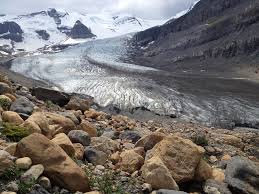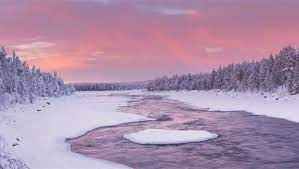Moraines
"Moraines: Landmarks of Ice Ages"
Moraines are geological landforms created by the deposition of glacial debris carried and pushed forward by moving glaciers. These formations are often composed of a mixture of rocks, boulders, sand, clay, and other sedimentary materials that were picked up and transported by the glacier as it moved over the landscape. Here's a more detailed description of moraines:

Formation: Moraines form as glaciers advance, retreat, or stagnate. Glaciers, which are massive sheets of ice, act like bulldozers, scraping and picking up rocks and sediment from the underlying terrain. As the glacier moves, it carries this material with it. When the glacier begins to melt or recede, it deposits this debris in various ways, creating moraines.
Types: There are several types of moraines, including:
Moraines are geological landforms created by the deposition of glacial debris carried and pushed forward by moving glaciers. These formations are often composed of a mixture of rocks, boulders, sand, clay, and other sedimentary materials that were picked up and transported by the glacier as it moved over the landscape. Here's a more detailed description of moraines:

Formation: Moraines form as glaciers advance, retreat, or stagnate. Glaciers, which are massive sheets of ice, act like bulldozers, scraping and picking up rocks and sediment from the underlying terrain. As the glacier moves, it carries this material with it. When the glacier begins to melt or recede, it deposits this debris in various ways, creating moraines.
Types: There are several types of moraines, including:
Terminal Moraine: Deposited at the farthest point reached by a glacier's advance.
Lateral Moraine: Found along the sides of a glacier and formed from debris scraped off the valley walls.
Medial Moraine: Created when two glaciers merge, and their lateral moraines combine in the center of the combined glacier.
Recessional Moraine: Created during a glacier's temporary periods of stabilization during a retreat.
Ground Moraine: A blanket of till (glacial sediment) left behind as a glacier retreats over a broad area.
Appearance: Moraines often appear as ridges, mounds, or irregularly shaped piles of rocks and sediment. They can vary in size from small hillocks to massive features spanning kilometers.
Composition: Moraines contain a wide range of materials, from small pebbles to large boulders, all mixed within a matrix of finer sediments. This composition reflects the types of rocks and sediments the glacier encountered on its journey.
Significance: Moraines are essential indicators of past glacial activity and can provide valuable insights into the Earth's geological history and the effects of climate change. They can also influence local ecosystems, hydrology, and human activities.
Human Interaction: Moraines often have cultural and recreational significance. They can serve as hiking destinations, provide insights into local history, and even influence land-use planning.
Environmental Impact: The study and preservation of moraines are crucial for understanding and mitigating the impact of climate change. As glaciers retreat, the release of meltwater from moraine-dammed lakes can pose flood risks to downstream areas.
Overall, moraines are fascinating geological features that offer a window into the Earth's glacial history and play a vital role in shaping landscapes and ecosystems.
Lateral Moraine: Found along the sides of a glacier and formed from debris scraped off the valley walls.
Medial Moraine: Created when two glaciers merge, and their lateral moraines combine in the center of the combined glacier.
Recessional Moraine: Created during a glacier's temporary periods of stabilization during a retreat.
Ground Moraine: A blanket of till (glacial sediment) left behind as a glacier retreats over a broad area.
Appearance: Moraines often appear as ridges, mounds, or irregularly shaped piles of rocks and sediment. They can vary in size from small hillocks to massive features spanning kilometers.
Composition: Moraines contain a wide range of materials, from small pebbles to large boulders, all mixed within a matrix of finer sediments. This composition reflects the types of rocks and sediments the glacier encountered on its journey.
Significance: Moraines are essential indicators of past glacial activity and can provide valuable insights into the Earth's geological history and the effects of climate change. They can also influence local ecosystems, hydrology, and human activities.
Human Interaction: Moraines often have cultural and recreational significance. They can serve as hiking destinations, provide insights into local history, and even influence land-use planning.
Environmental Impact: The study and preservation of moraines are crucial for understanding and mitigating the impact of climate change. As glaciers retreat, the release of meltwater from moraine-dammed lakes can pose flood risks to downstream areas.
Overall, moraines are fascinating geological features that offer a window into the Earth's glacial history and play a vital role in shaping landscapes and ecosystems.
#Moraine
#GlacialMoraine
#MoraineLandscape
#MoraineFormation
#MoraineGeology
#MoraineViews
#MoraineValley
#MoraineTrail
#MoraineAdventures
#MoraineExplorer
#MoraineHike
#MorainePhotography
#GlacialMoraine
#MoraineLandscape
#MoraineFormation
#MoraineGeology
#MoraineViews
#MoraineValley
#MoraineTrail
#MoraineAdventures
#MoraineExplorer
#MoraineHike
#MorainePhotography



Comments
Post a Comment